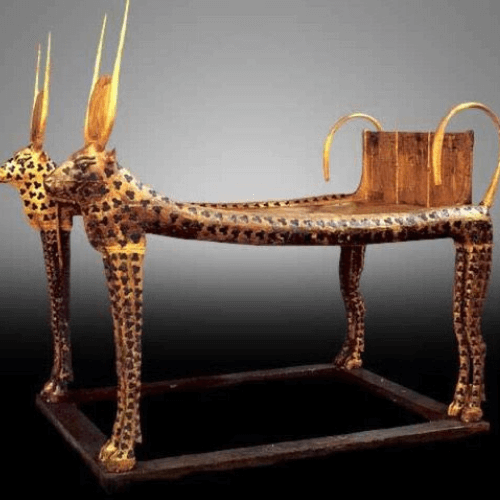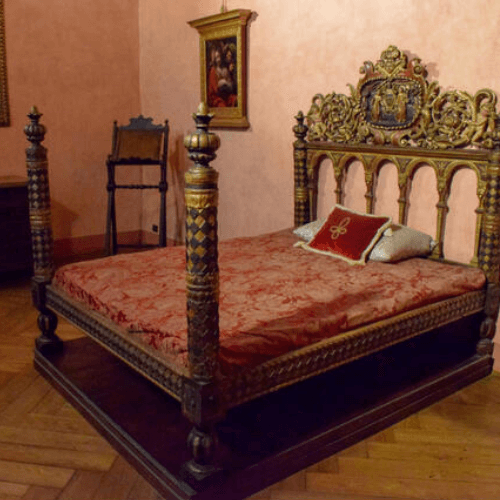Who invented the bed? It’s a question that has been asked for centuries.
From ancient civilizations to modern society, the need for a comfortable place to rest has been the same. But who was the first person to invent and build a bed?
It all began in prehistoric times; our early ancestors were known to sleep on piles of leaves and other vegetation. The evolution of beds can be traced through civilizations like Ancient Egypt, Rome and Greece, where beds were made with animal skins, plant fibers and wooden frames.
Over time, mattresses became stuffed with materials like feathers or straw, providing a much more comfortable sleeping surface than before.
Yet it wasn’t until the 19th century that the modern bed as we know it today was developed, with steel frames and box springs giving rise to an entirely new kind of mattress.
So who invented this revolutionary design?
Read on to find out!
Historical Context Of The Invention

Bed-making has been around for centuries. It can be traced back to the ancient civilizations of Mesopotamia, Egypt, Greece and Rome.
In these early cultures, beds were constructed from wood or stone and filled with straw, wool, or other materials.
The concept of a bed in its current form was developed over time as different cultures adapted the idea of an elevated platform for sleeping.
The modern bed is believed to be have been invented by the Romans in the 1st century AD.
This type of bed featured a wooden frame with interlocking pieces and a mattress filled with down feathers or hay.
The design allowed for easy assembly and disassembly and was comfortable enough to accommodate several people at once.
The invention of the modern bed had a significant impact on culture and society. It enabled people to sleep more comfortably than ever before, allowing them to rest longer and more deeply than before.
This provided individuals with greater physical energy and mental clarity during their waking hours and contributed to increased productivity as well as improved overall health.
Bed-making evolved further in subsequent years as new materials and technologies were developed, culminating in today’s comfortable mattresses and adjustable frames that are designed to meet individual needs.
Pre-Bed Sleeping Arrangements
For centuries, humans have been engaged in the quest for restful sleep.
The story of our slumber stretches back to a time when beds were nothing more than a distant dream. Before the invention of beds, humans had to make do with other sleeping arrangements.
To start, people got creative with the materials they had available.
Straw and hay were popular choices, as they were often abundant and easy to use.
People used them to craft makeshift mattresses and pillows, which provided some comfort but lacked the convenience of a bed.
Additionally, some people chose to sleep on the ground with no cushioning at all or even on tree branches if they could find sturdy ones high enough off the ground.
The most common pre-bed sleeping arrangement was probably animal skins stretched across frames of wood or stone.
These provided insulation from cold floors and also gave additional cushioning compared to just a mattress made of straw or hay.
Furthermore, sleeping bags made from animal skin would have been used by those who traveled often since they could be easily stored away when not in use.
As time passed, these primitive sleeping arrangements started to evolve into something resembling beds we know today.
With the invention of new materials like cotton and linen came even more comfortable and convenient ways to rest our heads at night – leading us eventually to where we are today!
The Earliest Bed Design
Surprisingly, the bed has been around for over 40,000 years.
This ancient invention has come a long way since its inception!
The earliest bed design dates back to the Stone Age.
This primitive sleeping arrangement was made of sticks and leaves bound together with animal skins and hides.
It was just enough to keep a person off the cold ground and provide some level of comfort.
In addition, it served as a source of warmth in cold climates by trapping body heat underneath the pile of materials used to construct it.
The Stone Age beds were laid directly on the ground and featured no frame or mattress. They were not even elevated like modern beds, making them uncomfortable to use by today’s standards.
However, they provided adequate support for those who used them during that time period.
This basic concept of sleep surfaces slowly evolved over time and grew more sophisticated in its design as humans progressed into different civilizations and cultures.

Ancient Egyptian Beds

Cradling our world’s history, the bed has existed since ancient times. Its evolution is an interesting journey through the ages, beginning with the earliest bed designs in prehistory and leading to the majestic creations of ancient Egypt.
The fourth chapter of this story brings us to the land of Pharaohs and pyramids, where beds were no longer just a pile of furs but rather pieces of exquisite furniture.
From modest pallets to luxurious daybeds, ancient Egyptians crafted cleverly designed beds from wood and leather.
They also used linen sheets and blankets for comfort and decoration, with some beds even featuring headrests for extra support.
In an effort to make their bedrooms more inviting and comfortable, ancient Egyptians took great pride in their bedding.
Some beds were even equipped with systems that allowed them to be raised off the ground for extra ventilation during hot summer months.
This was one way that these ingenious people showed their commitment to creating a haven of restful sleep.
Ancient Egyptian beds offered more than just comfort; they also symbolized wealth and power in society, as they often served as status symbols among royalty and elites.
With so much beauty and elegance, it’s no wonder these luxurious sleeping arrangements remain popular today.
Ancient Greek Beds
As the saying goes, old is gold! Ancient Greek beds were a shining example of this proverb.
Forged with ingenuity and care, these beds sparkled among their peers like a golden beacon.
From their sturdy frames to their luxurious mattresses, they epitomized comfort and style.
Here are some of the features that made them so special:
- Artistically designed headboards
- Intricate carvings in the bed frame
- Handcrafted mattresses stuffed with wool or feathers
- Beautiful bedspreads to add an extra layer of comfort
These beds had it all. They stood tall against time, becoming an integral part of everyday life for ancient Greeks.
Their majestic designs brought pleasure and relaxation to each room they inhabited, making them an essential piece of furniture for many centuries to come.
Ancient Greek beds left behind a legacy that still exists today.
They gave us a glimpse into the culture and lifestyle of our ancestors, inspiring us with their innovative designs and giving us a taste of true luxury.
Ancient Roman Beds

The ancient Roman beds were a sight to behold. Their intricate designs and carefully crafted materials made them a luxury item for the privileged few.
The frames were usually ornately carved from wood and the bedding was often made of fine fabric or animal hide.
Some of the most luxurious beds were even decorated with precious metals and stones such as gold, silver, and pearls.
The Romans had specific rules about what should be in a bedroom, including a bed that was large enough to fit two people comfortably.
This allowed husbands and wives to share the same sleeping area while still maintaining some privacy.
In addition, they also had specific standards for how much space should be between them when lying in bed together.
These ancient Roman beds are still admired today for their craftsmanship and attention to detail.
They remain an example of luxurious living that we can all strive for in our own homes.
As we look back on this period of history, it’s clear that these pieces of furniture provided comfort, beauty, and style to those who could afford them – something which is still important today.
Medieval Beds
The medieval era saw great advancement in bed design. The beds were made from heavier materials than those used by the Romans, such as oak and walnut.
They often featured high headboards and footboards to provide extra support for the mattress and the occupant.
While not as ornate as later designs, these beds were still quite attractive – some even had carved decorations on their surfaces.
Most interesting of all was the bed’s function in medieval culture: it wasn’t just a place to sleep; it served as an important status symbol too.
Nobles would often display their wealth through their bed designs – particularly when entertaining guests or hosting banquets in their homes.
Having a lavish bed was seen as a sign of good taste and prosperity – something many people strived for during this period of time.
Beds In The Renaissance And Baroque Eras
Beds have been around for centuries, and the Renaissance and Baroque eras saw some of the most interesting designs.
An estimated 80% of beds in European homes during this time were of the four-poster variety, making them a popular choice.
The four-poster bed design was first developed in Italy, and typically featured rich fabrics draped over posts at each corner.
This luxurious look was often seen as a status symbol, with wealthy families using more expensive materials than poorer households.
It also provided extra warmth in cold climates, as well as more privacy with curtains that could be drawn around it.
Coupled with the ornate carvings seen on many pieces from this period, these beds were works of art in their own right.
They became increasingly popular across Europe until they eventually evolved into the sleigh bed design of today.
Modern Beds
The modern bed has come a long way from the Renaissance and Baroque eras.
People today have the luxury of comfort and convenience with their beds that were not available to people before.
As we enter into the 20th and 21st centuries, major inventions in bed design are helping us rest more comfortably than ever before.
A great example of this is the adjustable bed.
An adjustable bed allows you to adjust your sleeping position to whatever makes you most comfortable.
In other words, it puts you in control of how you sleep, allowing you to maximize your sleeping time and get a good night’s rest.
In addition to adjustable beds, there are many innovations in mattress technology that are making beds more comfortable and supportive for everyone.
For example, memory foam mattresses provide pressure relief for joints and help reduce tossing and turning throughout the night.
Furthermore, air-filled mattresses eliminate motion transfer between sleep partners so that each person can get a good night’s rest without being disturbed by movement from their partner.
Finally, waterbeds offer improved weight distribution for better support throughout the night.
Bed Inventions In The 20th And 21st Centuries
Sleepers of the world have been tucking themselves in for centuries.
But who was the genius that invented the bed? Though it may be hard to pinpoint one person, a few stand out when looking at modern beds.
The 20th and 21st centuries brought with them a plethora of inventions related to beds. In 1901, steel coil springs were created by Edwin Fostor, bringing comfort and support to mattresses like never before.
And in 1931, adjustable beds were patented by Harvey D Karman, allowing people to sleep in positions which had previously been impossible.
Not long after that came waterbeds.
Created by Charles Hall in 1966, these beds allowed for more control over sleeping temperatures than ever before. From memory foam mattresses and hybrid mattresses to platform beds and adjustable frames, the bed-related inventions of recent years have pushed the boundaries of what we thought possible from our bedrooms.
While their inventors may remain mysterious, their impact on our lives is undeniable.
Frequently Asked Questions
What Are The Benefits Of Sleeping On A Bed?
A bed offers a number of benefits. It provides comfort, support, and stability to the user. Additionally, sleeping on a bed can also improve physical health. The comfort that a bed offers helps one to get more restful sleep.
The cushioning of the mattress and pillows help the body to relax and decompress after a long day. This can help reduce stress and improve overall mental wellbeing.
Finally, sleeping on a bed can have positive effects on physical health as well.
The support it provides helps keep the spine in alignment which can aid in pain relief for those with back problems. It can also help with circulation and provide better ventilation for those who suffer from allergies or asthma.
Sleeping on a bed can be beneficial in terms of both physical and mental wellbeing. Its comfort, support, and stability make it an important part of getting quality sleep and improving overall health.
Conclusion
I’ve been wondering who invented the bed, and I found the answer. It’s believed that the first beds were created around 5,000 years ago in Egypt and Mesopotamia.
The materials used to make these beds were mostly animal skins, straw or reeds.
Nowadays, we have a wide variety of beds to choose from depending on our budget and needs. The average modern bed can cost anywhere from $100 to thousands of dollars.
Beds provide us with a comfortable place to sleep, relieving stress on our bodies while we rest.
Unfortunately, sleeping on the wrong type of bed can cause health issues such as back pain, neck pain and poor circulation.
So it’s important to choose the right type of bed for a good night’s sleep.
According to research, an estimated 75% of people don’t get enough sleep due to an uncomfortable mattress or bed frame.
Overall, it’s clear that beds are essential for getting a good night’s rest and avoiding potential health risks associated with bad sleeping habits.
It’s amazing how far we’ve come since the first beds were created 5,000 years ago!





